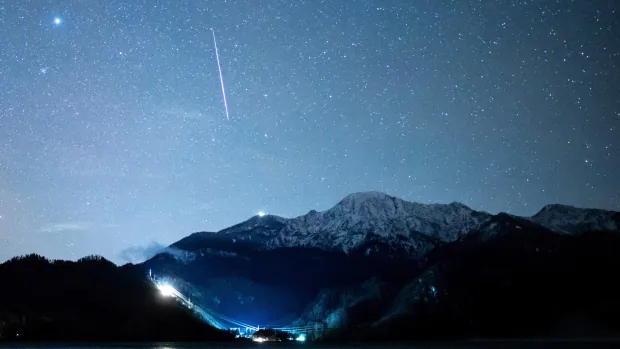We’re in the midst of the “best and most reliable” meteor shower of the year. Here’s where and when to look for the Geminids, and why the event still puzzles astronomers.
What is the Geminid meteor shower?
The Geminids, which happen every December, are “one of the best and most reliable annual meteor showers,” according to NASA.
Peter Brown, an astronomy professor at Western University in London, Ont., who studies meteor showers goes further, calling it the “strongest meteor shower of the year.”
What can you expect to see?
Meteors, also known as shooting stars, appear as points of light that streak across the sky. They’re caused by dust and small rocks passing into the atmosphere and burning up.
While you might see a meteor any night of the year, you can expect a lot more during a meteor shower, which occurs several times a year.
The <a href=”https://twitter.com/hashtag/Geminids?src=hash&ref_src=twsrc%5Etfw”>#Geminids</a> are coming… are you ready to capture the most famous <a href=”https://twitter.com/hashtag/meteor?src=hash&ref_src=twsrc%5Etfw”>#meteor</a> shower on camera? If not, find out how ➡ <a href=”https://t.co/eCTmdc9blB”>https://t.co/eCTmdc9blB</a> <a href=”https://t.co/sYxuQxPQLU”>pic.twitter.com/sYxuQxPQLU</a>
—@CanonEMEA
One of the best known showers is the Perseids, which happen in August and which many people see while out camping or at cottages.
But the Geminids produce meteors at about double the rate of the Perseids, said Brown. You can see more than two per minute when the December meteor shower is peaking.
“They last for several days. They’re quite rich and bright meteors. They’re slower than the Perseids,” Brown said. “So as a visual display … the Geminids are quite, quite spectacular.”
And in fact, the Geminid meteor shower has improved in recent decades, producing more meteors now than in the past, although researchers aren’t really sure why.
When and where should you look?
The Geminids are generally active from Dec. 4 to 17, and this year’s meteor shower is already underway. It also tends to be more active before its peak — overnight on Dec. 13-14 this year — than after.
“If people can get outside any time in the next four or five days, right up to next Wednesday, it’s definitely worth trying,” Brown said.
This year, the meteor shower will “definitely be strongest Monday night, Dec. 13, into Tuesday morning,” he said.
It’s official peak will be around 3 a.m. ET Tuesday.
Brown recommends people try to view the shower between 2 a.m. and dawn local time where they are, as the moon sets around then and skies will be darker, making the meteors easier to spot.
Two a.m. is also when the constellation Gemini, where the meteors will appear to originate, is highest in the sky.
Going somewhere dark, away from city lights, is also ideal.
No special equipment is needed; while the meteors will appear to originate from the constellation Gemini, they can move across any part of the sky, so all you need is a clear view that isn’t blocked by trees or buildings.
Viewing conditions are, of course, dependent on the weather, which tends to be cloudy across much of Canada at this time of year.
Brown recommends trying to see the meteors during any break in the clouds, or even trying to see them through holes in the clouds, given how active the meteor shower is.
What causes the shower of shooting stars?
The dust and rocks that cause meteor showers are usually left behind by comets, which spew gas and debris when their orbit brings them close to the heat of the sun. When the Earth passes through that trail of dust during its orbit, meteor showers happen.
Unlike most meteor showers, however, the Geminids come from an asteroid: 3200 Phaethon, named after the son of the Greek sun god Helios, as its orbit brings it close to the sun.
Asteroids don’t normally shed gas and dust like comets, so they don’t usually generate meteor showers. When 3200 Phaethon gets close to the sun, some of the rock itself does vaporize, said Brown.
“But even then, it currently does not produce much in the way of dust,” he said.
It’s also only 5.1 kilometres in diameter — surprising given the amount of debris it produced, NASA says.
Astronomers think the dust and rocks that cause the Geminids were left behind by 3200 Phaethon hundreds or even a thousand years ago. “But exactly how, we still don’t know,” Brown said.
It’s possible that the debris was caused by a collision, or that Phaethon really is a comet, but now looks like an asteroid because it’s been covered by dust.

What’s more, it doesn’t look like 3200 Phaethon is shedding more material, so that’s not why the Geminid meteor shower is getting stronger. It’s more likely that Earth is passing through a more concentrated part of the debris.
Brown said he and his team are planning to do some modelling in the next year or so in order to better understand what causes the Geminid meteor shower: “I think it’s about time we finally get down and start really working through.”


